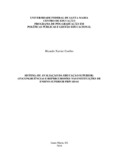| dc.creator | Coelho, Ricardo Xavier | |
| dc.date.accessioned | 2019-06-25T15:59:48Z | |
| dc.date.available | 2019-06-25T15:59:48Z | |
| dc.date.issued | 2018-08-30 | |
| dc.identifier.uri | http://repositorio.ufsm.br/handle/1/17122 | |
| dc.description.abstract | The present theme is inserted in thepedagogic universe of a significantpiece of gestores and teachers of thesuperior education. In the academiclife, to whom it dedicates to her, certainly, in the past or very muchsoon, it will be led to know on thesystem of evaluation of the superioreducation, be to understand it or thento receive the valuators of the MEC, who to the end and to the end will betesting the professional competencesof the IES and of the teachersthemselves and gestores academics. The System of Evaluation of theSuperior Education is supervised bythe Public Administration throughLaws, Decrees and Entrance halls thatregularize which the characteristicsthe teaching must have. It takes placewhat in this mission prunes that thestandards themselves of the organresponsible for the inspection of theeducation have formal and legalincongruence with sufficient force toproduce damages to the Gestor and, consequently, to the IES herself. In thissense, the present inquiry aims tosystematize the legislation thatgoverns the evaluation of the superioreducation in the Br, chiefly in whatrefers to the processes of renovationof recognition of Courses, so that oneidentifies eventual problems that onlywould be discovered by the Gestoresafter the realization of the evaluationsfor the responsible organs. To manage, matters in administering disagreeingsceneries, for times. The importance ofthe present study, then, concentrateson the fact that the identification ofeventual incongruence in the systemof evaluation of the superior educationhas the perspective of, alerting onsuch faults, to avoid that IES relapsesinto obscure gaps, which to the endand to the end will reduce hisinstitutional capacity. There is facedthe cotejamento of the legislation thatgoverns the renovations of recognitionof Courses in the superior teaching, when the outline is taken into accountdoutrinário education. | eng |
| dc.language | por | por |
| dc.publisher | Universidade Federal de Santa Maria | por |
| dc.rights | Attribution-NonCommercial-NoDerivatives 4.0 International | * |
| dc.rights.uri | http://creativecommons.org/licenses/by-nc-nd/4.0/ | * |
| dc.subject | Renovação de reconhecimento de cursos | por |
| dc.subject | Avaliação da educação superior | por |
| dc.subject | Sistema nacional de avaliação da educação superior | por |
| dc.subject | SINAES | por |
| dc.subject | Gestão da educação superior | por |
| dc.subject | Renovation of recognition ofCourses | eng |
| dc.subject | Evaluation of the superioreducation | eng |
| dc.subject | National system of evaluationof the superior education | eng |
| dc.subject | Management of the superior education. | eng |
| dc.title | Sistema de avaliação da educação superior: (in)congruências e repercurssões nas insituições de ensino superior privadas | por |
| dc.title.alternative | Higher education evaluation system: (in) congruences and repercussions in private higher education institutions | eng |
| dc.type | Dissertação | por |
| dc.description.resumo | Esta temática habita o universo pedagógico de uma parcela significativa de gestores e professores da educação superior. Na vida acadêmica, a quem se dedica a ela, certamente, no passado ou muito em breve, será levado a conhecer sobre o sistema de avaliação da educação superior, seja para compreendê-lo ou então para receber os avaliadores do MEC, que ao fim e ao cabo estarão testando as competências profissionais das IES e dos próprios docentes e gestores acadêmicos. O Sistema de Avaliação da Educação Superior é fiscalizado pela Administração Pública através de Leis, Decretos e Portarias que regulamentam quais as características o ensino deve possuir. Ocorre que nessa missão, as próprias normas do órgão responsável pela fiscalização da educação possuem incongruências formais e legais com força suficiente para gerar prejuízos ao Gestor e, por consequência, à própria IES. Para estudar os entornos desta situação, a presente pesquisa partiu de um estudo de caso, por meio de um intenso estudo bibliográfico/documental, com abordagem qualitativa e enfoque na análise de conteúdos legal/normativo que envolve a temática, em cruzamento entre a área da educação e a área do direito. Uma clara sistematização do desenvolvimento da avaliação institucional no Brasil, nas últimas décadas, mostra a persistência das disputas neste campo e o esvaziamento conceitual das práticas de avaliação, cercando e enquadrando a formação dos discentes e a atuação de docentes e de gestores, em função dos seus ditames, marcados por equívocos e visão unívoca (p. 109). Assim, a pesquisa tensiona a territorialidade que habita sua temática e funde-se em um caráter transformador da sua realidade, pois ao estudar suas múltiplas dimensões ou intervenientes1 – voluntários ou involuntários pode criar condições para que se perceba, criticamente, o jogo e as armadilhas que impedem mudanças e avanços efetivos na qualidade da educação, em movimentos que conduzem a um desperdício de força institucional e descrédito no processo. Enfrenta-se o cotejamento da legislação que rege as renovações de reconhecimento de Cursos no ensino superior, levando-se em consideração o arcabouço doutrinário educacional a partir do caso em estudo. | por |
| dc.contributor.advisor1 | Veiga, Adriana Moreira da Rocha | |
| dc.contributor.advisor1Lattes | http://lattes.cnpq.br/9245252793422468 | por |
| dc.contributor.referee1 | Dalla Corte, Marilene Gabriel | |
| dc.contributor.referee1Lattes | http://lattes.cnpq.br/1554366181630485 | por |
| dc.contributor.referee2 | Ghidolin, Clodoveo | |
| dc.contributor.referee2Lattes | http://lattes.cnpq.br/3147142162161654 | por |
| dc.creator.Lattes | http://lattes.cnpq.br/7865615603529100 | por |
| dc.publisher.country | Brasil | por |
| dc.publisher.department | Educação | por |
| dc.publisher.initials | UFSM | por |
| dc.publisher.program | Programa de Pós-Graduação em Políticas Públicas e Gestão Educacional | por |
| dc.subject.cnpq | CNPQ::CIENCIAS HUMANAS::EDUCACAO | por |
| dc.publisher.unidade | Centro de Educação | por |



